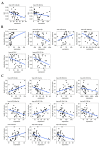Relationships between Indicators of Lower Extremity Artery Disease and miRNA Expression in Peripheral Blood Mononuclear Cells
- PMID: 35329950
- PMCID: PMC8948757
- DOI: 10.3390/jcm11061619
Relationships between Indicators of Lower Extremity Artery Disease and miRNA Expression in Peripheral Blood Mononuclear Cells
Abstract
Lower extremity artery disease (LEAD) is an underdiagnosed and globally underestimated vascular disease caused by the progressive and chronic formation of atherosclerotic plaques in the arteries of the lower limbs. Much evidence indicates that the abnormal course of pathophysiological processes underlying LEAD development is associated with altered miRNA modulatory function. In the presented study, relationships between miRNA expression and clinical indicators of this disease (ABI, claudication distance, length of arterial occlusion, Rutherford category, and plaque localization) were identified. MiRNA expression profiles were obtained using next-generation sequencing in peripheral blood mononuclear cells (PBMCs) of 40 LEAD patients. Correlation analysis performed using the Spearman rank correlation test revealed miRNAs related to ABI, claudication distance, and length of arterial occlusion. In the DESeq2 analysis, five miRNAs were found to be dysregulated in patients with Rutherford category 3 compared to patients with Rutherford category 2. No miRNAs were found to be differentially expressed between patients with different plaque localizations. Functional analysis performed using the miRNet 2.0 website tool determined associations of selected miRNAs with processes underlying vascular pathology, such as vascular smooth muscle cell differentiation, endothelial cell apoptosis, response to hypoxia, inflammation, lipid metabolism, and circadian rhythm. The most enriched functional terms for genes targeted by associated miRNAs were linked to regulation of the cell cycle, regulation of the transcription process, and nuclear cellular compartment. In conclusion, dysregulations of miRNA expression in PBMCs of patients with LEAD are indicative of the disease and could potentially be used in the prediction of LEAD progression.
Keywords: ankle brachial index; atherosclerosis; claudication; lower extremity artery disease; miRNA; miRNA expression; next generation sequencing; peripheral arterial disease.
Conflict of interest statement
The authors declare no conflict of interest.
Figures




Similar articles
-
miRNA Regulatory Networks Associated with Peripheral Vascular Diseases.J Clin Med. 2022 Jun 16;11(12):3470. doi: 10.3390/jcm11123470. J Clin Med. 2022. PMID: 35743538 Free PMC article.
-
Application of OpenArray RT-qPCR for identification of microRNA expression signatures of lower extremity artery disease.J Appl Genet. 2022 Sep;63(3):497-512. doi: 10.1007/s13353-022-00692-1. Epub 2022 Apr 2. J Appl Genet. 2022. PMID: 35366714
-
Stenting for peripheral artery disease of the lower extremities: an evidence-based analysis.Ont Health Technol Assess Ser. 2010;10(18):1-88. Epub 2010 Sep 1. Ont Health Technol Assess Ser. 2010. PMID: 23074395 Free PMC article.
-
Ankle-brachial index use in peripheral vascular interventions for claudication.J Vasc Surg. 2022 Jul;76(1):196-201. doi: 10.1016/j.jvs.2022.02.049. Epub 2022 Mar 8. J Vasc Surg. 2022. PMID: 35276260 Review.
-
MicroRNAs in the atherosclerotic plaque.Clin Chem. 2013 Dec;59(12):1708-21. doi: 10.1373/clinchem.2013.204917. Epub 2013 May 31. Clin Chem. 2013. PMID: 23729638 Review.
References
-
- Aboyans V., Ricco J.-B., Bartelink M.-L.E.L., Björck M., Brodmann M., Cohnert T., Collet J.-P., Czerny M., De Carlo M., Debus S., et al. 2017 ESC Guidelines on the Diagnosis and Treatment of Peripheral Arterial Diseases, in Collaboration with the European Society for Vascular Surgery (ESVS) Eur. Heart J. 2018;39:763–816. doi: 10.1093/eurheartj/ehx095. - DOI - PubMed
-
- Fowkes F.G.R., Rudan D., Rudan I., Aboyans V., Denenberg J.O., McDermott M.M., Norman P.E., Sampson U.K., Williams L.J., Mensah G.A., et al. Comparison of Global Estimates of Prevalence and Risk Factors for Peripheral Artery Disease in 2000 and 2010: A Systematic Review and Analysis. Lancet. 2013;382:1329–1340. doi: 10.1016/S0140-6736(13)61249-0. - DOI - PubMed
-
- Song P., Rudan D., Zhu Y., Fowkes F.J.I., Rahimi K., Fowkes F.G.R., Rudan I. Global, Regional, and National Prevalence and Risk Factors for Peripheral Artery Disease in 2015: An Updated Systematic Review and Analysis. Lancet Glob. Health. 2019;7:e1020–e1030. doi: 10.1016/S2214-109X(19)30255-4. - DOI - PubMed
-
- Vuylsteke M.E., Colman R., Thomis S., Guillaume G., Van Quickenborne D., Staelens I. An Epidemiological Survey of Venous Disease Among General Practitioner Attendees in Different Geographical Regions on the Globe: The Final Results of the Vein Consult Program. Angiology. 2018;69:779–785. doi: 10.1177/0003319718759834. - DOI - PubMed
Grants and funding
LinkOut - more resources
Full Text Sources

